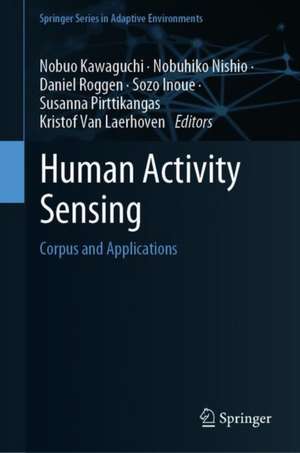Human Activity Sensing: Corpus and Applications: Springer Series in Adaptive Environments
Editat de Nobuo Kawaguchi, Nobuhiko Nishio, Daniel Roggen, Sozo Inoue, Susanna Pirttikangas, Kristof Van Laerhovenen Limba Engleză Hardback – 24 sep 2019
This book deals with the challenges of designing valid and reproducible experiments, running large-scale dataset collection campaigns, designing activity and context recognition methods that are robust and adaptive, and evaluating activity recognition systems in the real world with real users.
| Toate formatele și edițiile | Preț | Express |
|---|---|---|
| Paperback (1) | 643.83 lei 6-8 săpt. | |
| Springer International Publishing – 24 sep 2020 | 643.83 lei 6-8 săpt. | |
| Hardback (1) | 650.08 lei 6-8 săpt. | |
| Springer International Publishing – 24 sep 2019 | 650.08 lei 6-8 săpt. |
Preț: 650.08 lei
Preț vechi: 812.60 lei
-20% Nou
Puncte Express: 975
Preț estimativ în valută:
124.39€ • 130.34$ • 102.83£
124.39€ • 130.34$ • 102.83£
Carte tipărită la comandă
Livrare economică 12-26 aprilie
Preluare comenzi: 021 569.72.76
Specificații
ISBN-13: 9783030130008
ISBN-10: 3030130002
Pagini: 225
Ilustrații: XII, 250 p. 140 illus., 98 illus. in color.
Dimensiuni: 155 x 235 mm
Greutate: 0.54 kg
Ediția:1st ed. 2019
Editura: Springer International Publishing
Colecția Springer
Seria Springer Series in Adaptive Environments
Locul publicării:Cham, Switzerland
ISBN-10: 3030130002
Pagini: 225
Ilustrații: XII, 250 p. 140 illus., 98 illus. in color.
Dimensiuni: 155 x 235 mm
Greutate: 0.54 kg
Ediția:1st ed. 2019
Editura: Springer International Publishing
Colecția Springer
Seria Springer Series in Adaptive Environments
Locul publicării:Cham, Switzerland
Cuprins
Optimizing of the Number and Placements of Wearable IMUs for Automatic Rehabilitation Recording.- Identifying Sensors via Statistical Analysis of Body-Worn Inertial Sensor Data.- Compensation Scheme for PDR using Component-wise Error Models.- Towards the Design and Evaluation of Robust Audio-Sensing Systems.- A Wi-Fi Positioning Method Considering Radio Attenuation of Human Body.- Drinking gesture recognition from poorly annotated data: a case study.- Understanding how Non-experts Collect and Annotate Activity Data.- MEASURed: Evaluating Sensor-based Activity Recognition Scenarios by Simulating Accelerometer Measures from Motion Capture.- Benchmark performance for the Sussex-Huawei locomotion and transportation recognition challenge 2018.- Effects of Activity Recognition Window Size and Time Stabilization in the SHL Recognition Challenge.
Textul de pe ultima copertă
Activity recognition has emerged as a challenging and high-impact research field, as over the past years smaller and more powerful sensors have been introduced in wide-spread consumer devices. Validation of techniques and algorithms requires large-scale human activity corpuses and improved methods to recognize activities and the contexts in which they occur.
This book deals with the challenges of designing valid and reproducible experiments, running large-scale dataset collection campaigns, designing activity and context recognition methods that are robust and adaptive, and evaluating activity recognition systems in the real world with real users.
This book deals with the challenges of designing valid and reproducible experiments, running large-scale dataset collection campaigns, designing activity and context recognition methods that are robust and adaptive, and evaluating activity recognition systems in the real world with real users.
Caracteristici
The first collection of best practices and methodologies for activity recognition, by some of the most experienced activity recognition experts A community-based approach to assemble study results and data set collections from common human activities Latest trends and challenge definitions in the area of context and activity recognition






